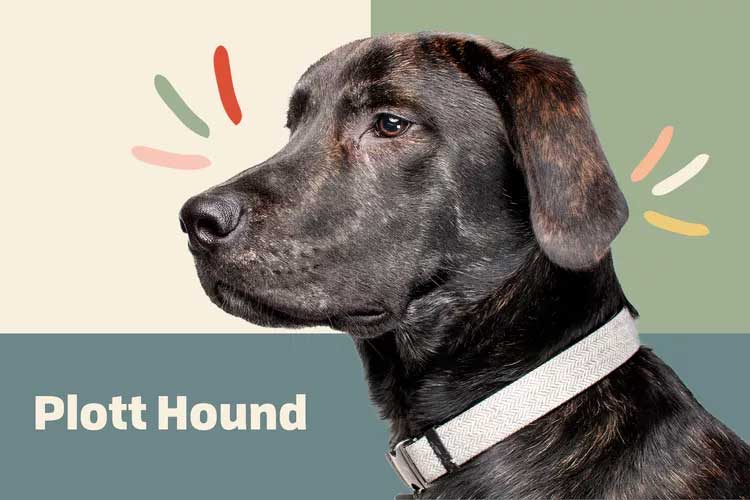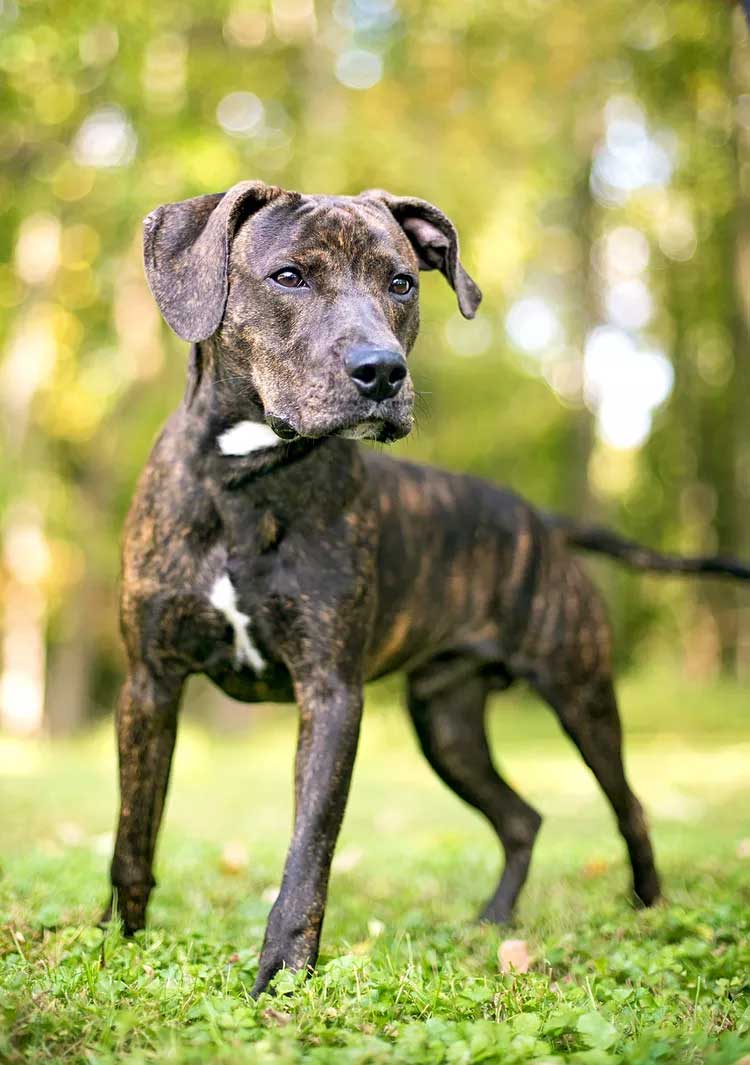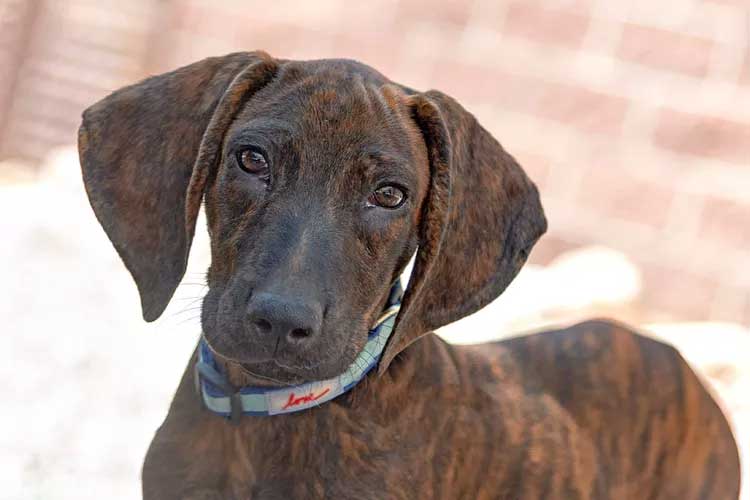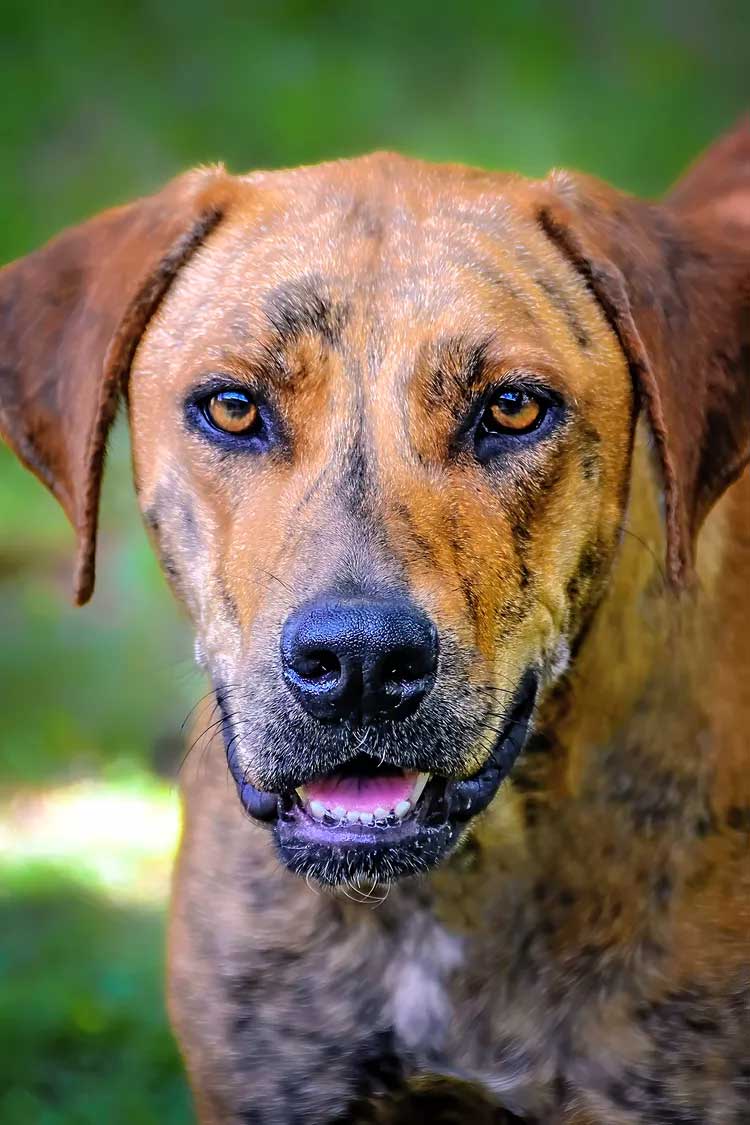
Plott hound Overview
| OFFICIAL NAME | Plott hound |
| COMMON NAME | Plott hound |
| PET HEIGHT | 20 to 25 inches |
| PET WEIGHT | 40 to 60 pounds |
| LIFESPAN | 12 to 14 years |
| GOOD WITH | children, dogs, families |
| TEMPERAMENT | aloof, friendly, playful |
| INTELLIGENCE | high |
| SHEDDING AMOUNT | normal |
| EXERCISE NEEDS | high |
| ENERGY LEVEL | active |
| VOCAL LEVEL | frequent |
| DROOL AMOUNT | medium |
| BREED GROUP | hound |
| BREED SIZE | medium (26-60 lbs.) |
| COAT LENGTH | short |
| COLORS | black, blue, brown / chocolate / liver, cream, fawn, gold / yellow, gray, red, white |
| PATTERNS | bicolor, brindle, saddle / blanket, tricolor |
| OTHER TRAITS | easy to groom, easy to train, good hiking companion, high prey drive, loves water, strong loyalty tendencies |
The Plott hound is an all-American dog, one of only a handful of American Kennel Club (AKC)-registered breeds that were developed in the United States. They're sleek, athletic, mid-sized dogs with a short, easy-to-groom brindle coat and a steady bark—be prepared for a vocal dog.
Bred for tracking down bears and boars, Plott hounds are tenacious and also unwaveringly loyal to their humans. While the breed is popular with hunters and outdoor enthusiasts in the Carolinas, the dogs are only slowly becoming better known outside of the region and weren't recognized by the AKC until 2006.
Appearance
The Plott hound is a medium-sized dog, fairly compact for a coonhound, with males measuring 20–25 inches tall and females 20–23 inches. A male Plott hound will weigh in around 50–60 pounds, and females will weigh 40–55 pounds. In other words, they're not enormous—they're well-muscled but lithe, with a streamlined form, a deep chest, and a long tail.
One of the most striking features of the Plott hound is his vivid, glossy coat, which typically comes in various shades of brindle: yellow to red to chocolate to blue. On rare occasions, according to the breed standard, a Plott hound will have a buckskin coat with shades from light cream to golden tan. They have long ears, brown or hazel eyes, and a confident, inquisitive expression.
Temperament
The Plott hound is a loyal breed, devoted to his family, and, when well-socialized, excellent with children. Plotts were bred to both hunt down bears and guard the family, so they had to be brave enough to go after enormous game while being a loyal and trusty companion at home. Because of this intense loyalty, they can sometimes be aloof with strangers."They like to size people up and say, 'Well, do I want you to pet me or not?'" says Christina Officer, president of the Plott Hound Association of America and a Plott hound breeder with over 20 years of experience. That being said, while they can be wary of strangers, they'll take their cues from their owners and are friendly dogs overall. Plott hound puppies need early and consistent socialization to be polite and learn that strangers don't have to be scary.

Like many dogs bred for tracking down prey, the Plott hound will require some training to get used to a cat. It's easier to bring a young dog into a home with a cat who already lives there. With other dogs, however, the Plott hound is perfectly content. They're pack dogs and happy to be among their own kind.
The Plott hound bark is a slightly high-pitched baying that helps them hunt successfully. Rather than carry small game like a retriever or bring down deer like a sighthound, the Plott hound was bred to track down bears, raccoons, mountain lions, and wild boars until their prey is cornered or stuck up in a tree. At that point, the Plott hound will communicate where their prey is with a steady, loud baying. At times, they'll stay on the track or tree for days; they're tenacious.
Living Needs
While other breeds have slowly drifted away from the fields and forests, the Plott hound is regularly sought out as a hunting companion, especially in the woods of the Carolinas, Georgia, and surrounding regions. Their athletic nature makes them an intrepid hunting dog and an all-around excellent outdoor companion (they're excellent swimmers, too). Officer suggests keeping them on a lead if you're just outdoors to hike, however. "While you hike in the woods, they're going to go hunt," she explains. "They may come back to you, but you may have to go off the path and get them off the tree."Plott hounds are dogs that live for the outdoors and need plenty of activity, so they're best suited for homes with lots of room and outside access. "They make wonderful house pets, but they are big," Officer says.
Because of their high activity level, the Plott hound needs regular, thorough exercise. If you're not actively hunting with your dog, you'll need to make sure they have plenty of space in a securely fenced yard, regular walks, and mentally stimulating physical activities, like games of fetch and tug-of-war. Officer also suggests getting your dog involved in sports, including hunting-oriented events like field trials, night hunts, and water races.
Care
The Plott hound's smooth, short coat is pretty low-maintenance. There are certain lines of Plott hounds developed for colder climates with slightly heavier coats, and while these pups will shed more, they still don't need much grooming, Officer says. Some regular brushing and nail clipping, as well as a bath every once in a while when they get dirty, are usually sufficient. Make sure to regularly inspect your Plott hound's ears and clean any debris or ear wax with soft gauze, if needed.Plott hounds are, in general, very easy to train because they are highly intelligent and eager to please. They're easily motivated with food and with praise, and (as with all dog breeds) Officer says consistency and positive reinforcement are key. Their intelligence, however, can sometimes work against you. "They get very bored if you continue to do the same thing over and over and over without giving them something to change it up," Officer says.

It's also important to remember Plott hounds have a powerful sense of smell—and all the instincts that come with it. They can get intensely curious about a scent and be distracted while on walks (which is why it's important to keep them on a leash), and are also known to sniff out food at home. "They like to counter surf; they got a good nose on them!" Officer says.
Because Plott hounds are so attached to their families, they don't like to be left alone for very long stretches of time. They do well with other dogs in the home and love quality time with their families.
Health
The Plott hound is a generally healthy breed. But, as with all breeds, there are some health conditions these pups are susceptible to.Like other breeds with a deep chest, they can be at risk of bloat, which is when gas in the stomach twists the organ and cuts off circulation. It's important for dog owners to recognize the symptoms of bloat and get their dog to the vet as soon as possible, as bloat quickly becomes life-threatening.
Some Plott hounds exhibit hip dysplasia, a condition in which the hip socket is abnormally formed, eventually causing a crippling lameness. It's more common in larger dogs, and being overweight can make it worse. Hip dysplasia is genetic, but it can be treated with physical therapy, medicines, and surgery.
History
The Plott hound is a unique breed. Not only are the dogs one of just a few American-developed breeds registered with the AKC, but they're also the only American breed that's descended from a German lineage.The Plott hound's story begins in 1750, when Johannes Plott immigrated to North Carolina along with five Hanover hounds he brought with him, according to the North Carolina Museum of History. Plott was descended from a long line of gamekeepers in the Black Forest in Germany, and he and his family were soon breeding the pack to local stock, resulting in the distinct, long-eared hounds we know today.
Their fame as courageous hunting dogs spread throughout the region, and the "Plott dog" became a sought-after breed. Johannes Plott's grandsons further refined the hound, at times disagreeing over whether to breed the dog solely for hunting ability or whether to standardize the appearance as well (some of these debates continue today). By the 1930s, many people outside of the Plott family were also dedicated Plott hound owners (and sometimes, breeders). And in 2006, the AKC recognized the Plott hound as an official breed.
Fun Facts
The Plott hound was named the official state dog of North Carolina in 1989. The Plott family developed the breed in the state in the mid-1700s.In modern times, the Plott hound has become more than just a hunter and state symbol. They're also used in police departments and as service dogs.
A handful of Plott hounds are on Instagram, including Daícota, a glossy, dark Plott hound living in the Pacific Northwest with a family of happy hounds. Scout, a brindle hound, goes on lots of fun hikes with his family in Arizona. And then there's Henry, a young Plott in upstate New York who loves hanging out with his best bud, a human toddler.